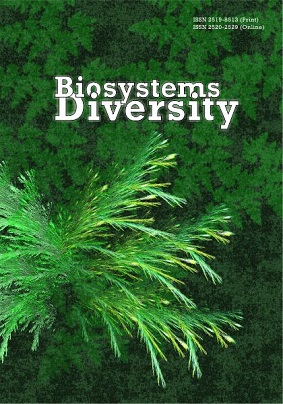Сезонна динаміка угруповань прибережного зоопланктону річки Удай у межах Національного природного парку «Пирятинський»
Seasonal dynamics of the littoral zooplankton groups of the Uday River within the National Nature Park "Pyryatynsky"
Author(s): V. P. Gandzyura, V. M. Trokhymets, Z. V. BurianSubject(s): Regional Geography, Environmental Geography, Human Ecology, Sociobiology
Published by: Дніпропетровський національний університет імені Олеся Гончара
Keywords: zooplankton; seasonal dynamics; Uday River; Ukraine;
Summary/Abstract: The increase in anthropogenic impact on aquatic ecosystems causes significant alterations in the composition and structure of hydrobiont groups. These processes are characteristic of the hydrobiocenoses of the Uday River, the valley of which lies within the National Nature Park "Pyryatynsky", established in 2009 in the Pyryatyn district of Poltava region. Within this protected area it is convenient to carry out continuous monitoring of changes in anthropogenic load on shore ecosystems of the river. One of the most convenient monitoring groups is zooplankton, which is one of the essential components of the trophic networks of aquatic ecosystems and which is the feeding basis of planktonophagous and young fish. The object of this research was the major groups of zooplankton: rotifers (class Eurotatoria), cladocerans (class Branchiopoda, order Cladocera), different age stages of copepods (class Copepoda), ostracods (class Ostracoda). Zooplankton were collected in the daytime in spring (mid April), summer (end of July) and autumn (late September) 2016 within eight research stations. As a result of the conducted research, 69 species of zooplankton were registered within the littoral water area of the Uday River. Monogonont rotifers numbered 19 (27.5%) species, bdelloid rotifers (subclass Bdelloidea), cladocerans – 33 (47.9%) species, copepods – 17 (24.6%). According to the faunal spectrum in the zooplankton groups, representatives of the cladoceran complex predominated. This is due to the favourable conditions for the development of filtrators, of which a considerable part is cladocerans. Three species of rotifers were identified in Poltava region for the first time: Beauchampiella eudactylota (Gosse, 1886), Dipleuchlanis propatula (Gosse, 1886), Mytilina acanthophora (Hauer, 1938). During the spring, 33 species of zooplankton were collected: rotifers – 10 species, cladocerans – 14, copepods – 9 species. In summer 41 species were registered, including rotifers – 10, cladocerans – 18, and copepods – 13. In autumn 37 species were found: 6 species of rotifers, cladocerans – 21 and copepods – 10. The species composition of the zooplankton in different seasons had a low similarity, as evidenced by Jaccard index: spring and autumn (J = 25,4), spring and autumn (J = 34,5), and summer and autumn (J = 34,6). In the spring, pelagic (36.3%) and phytophilic (45.6%) groups prevailed, and phytophilic dominated in summer (41.4%) and autumn (48.7%). Of the various groups classified according to feeding type, representatives of the peaceful group dominated in all the studied seasons, in spring comprising 69.7%, in summer – 65.8%, and in autumn – 73%. The density and biomass of zooplankton of the Uday River were “low” in spring and summer, and "very low" – in autumn.
Journal: Biosystems Diversity
- Issue Year: 25/2017
- Issue No: 3
- Page Range: 197-202
- Page Count: 6
- Language: Ukrainian

